Born in Withernsea, a town on the outskirts of Hull in Yorkshire, artist Richie Culver came to London in 2000. The 17-year-old was following his girlfriend to the capital with only £8 in his pocket.
Ten years later, Richie laid the foundations for his career in art by creating his first artistic work: a magazine cut-out of a Jesse Owens photo with the words ‘Have you ever really loved anyone?’ stuck onto it. Despite having not had any formal training, his first art work was immediately featured in a group exhibition at Tate Modern. Since then Richie has been experimenting with photography, mixed-media installations, paintings and constitutes collages and the matching of words with images his strength. His work is heavily autobiographical, his ‘I loved you’ paintings for example were inspired by an attempt of Richies to get his ex-fiancé back; he climbed up the back of her house one night, went on to the roof, and sprayed exactly these words above her bedroom window.
In December we visited Richie at his home in West London, on a calm picturesque street in Notting Hill, far away from the fashionable East End. The apartment, located on the first floor of a Victorian house, radiated a deserted atmosphere. Sparsely furnished, yet full of personality, both future works and finished pieces sat side by side amidst a not so cohesive collection of bits and bobs.
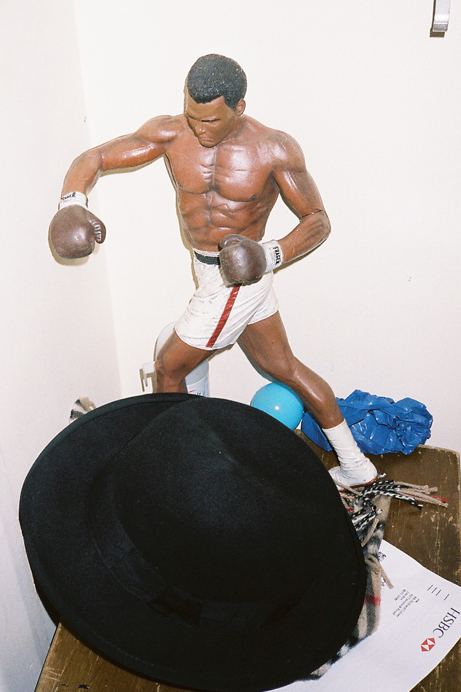
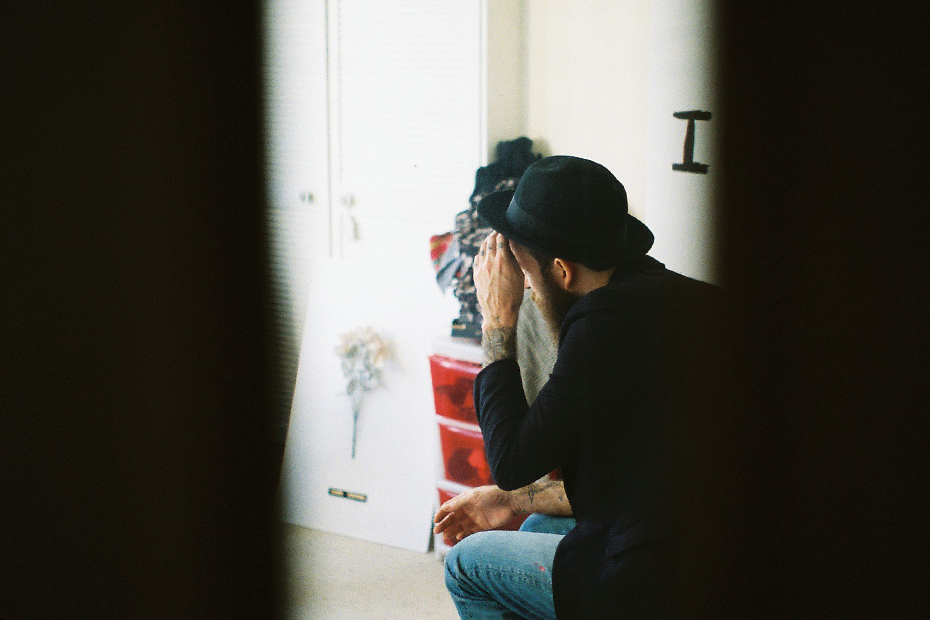
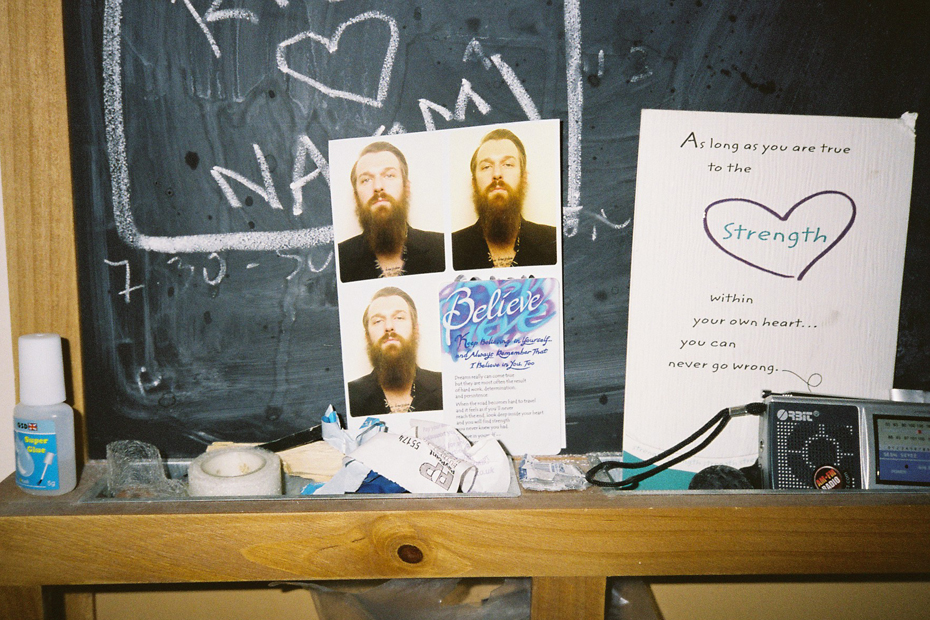
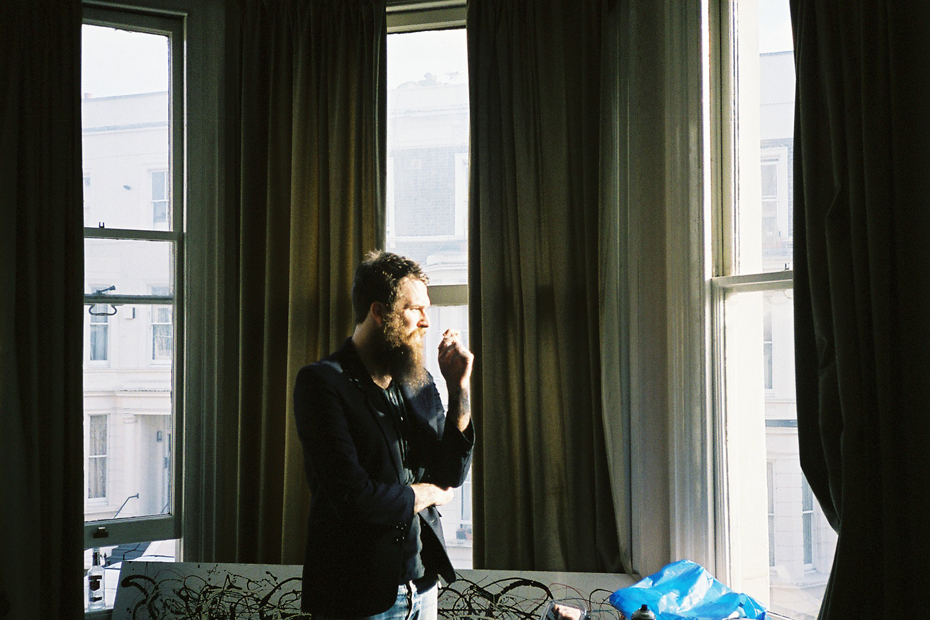
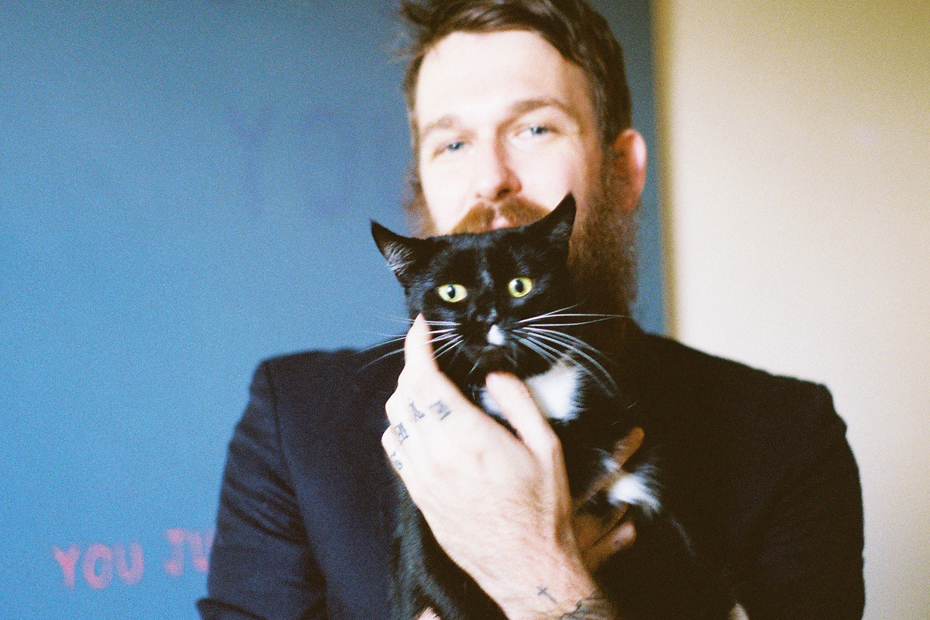
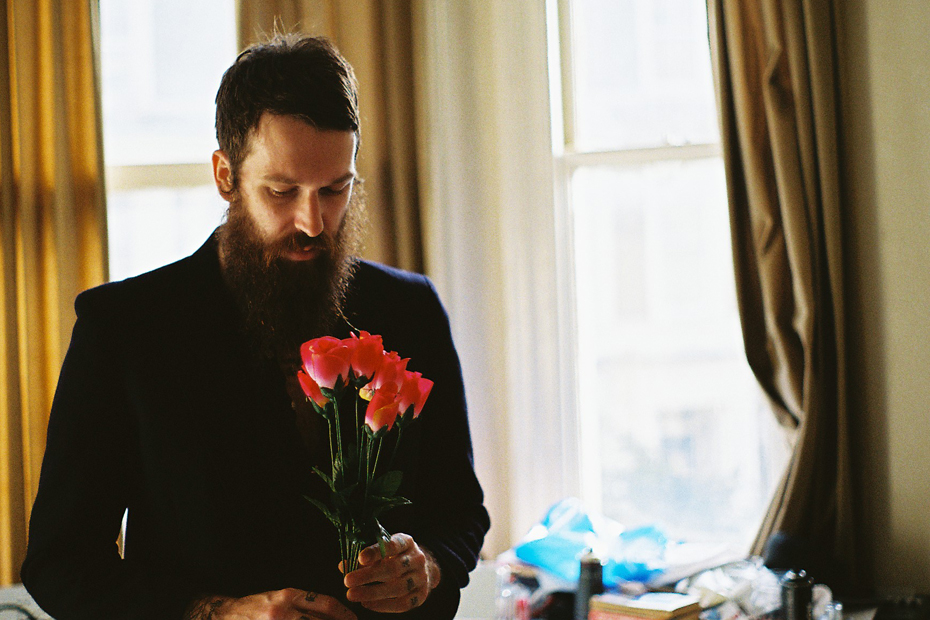
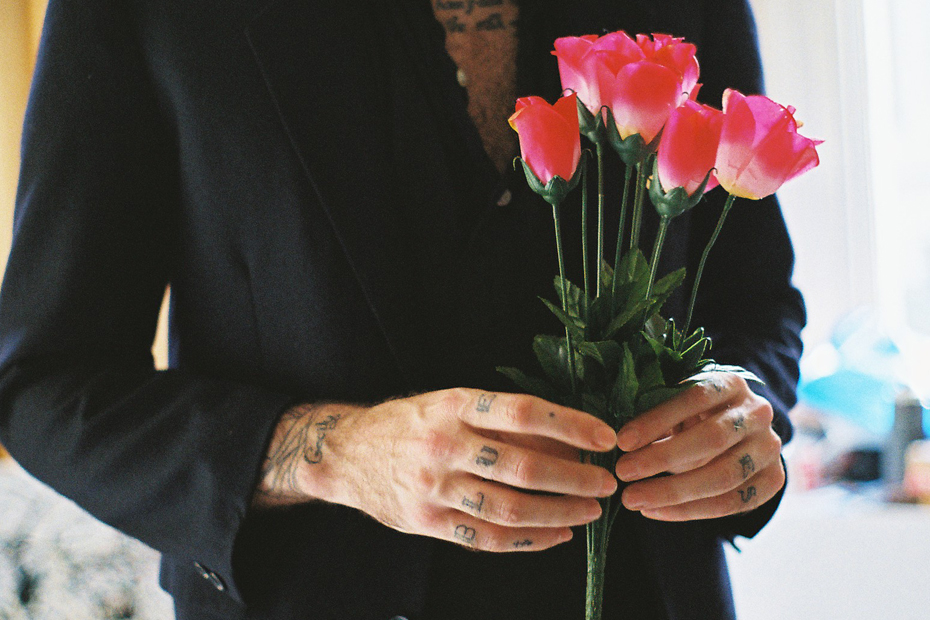
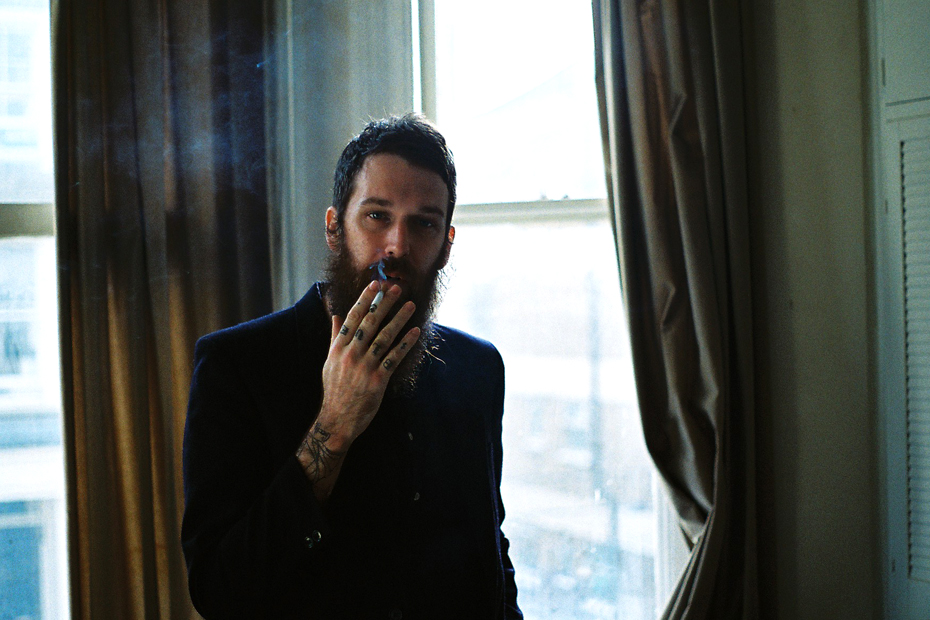
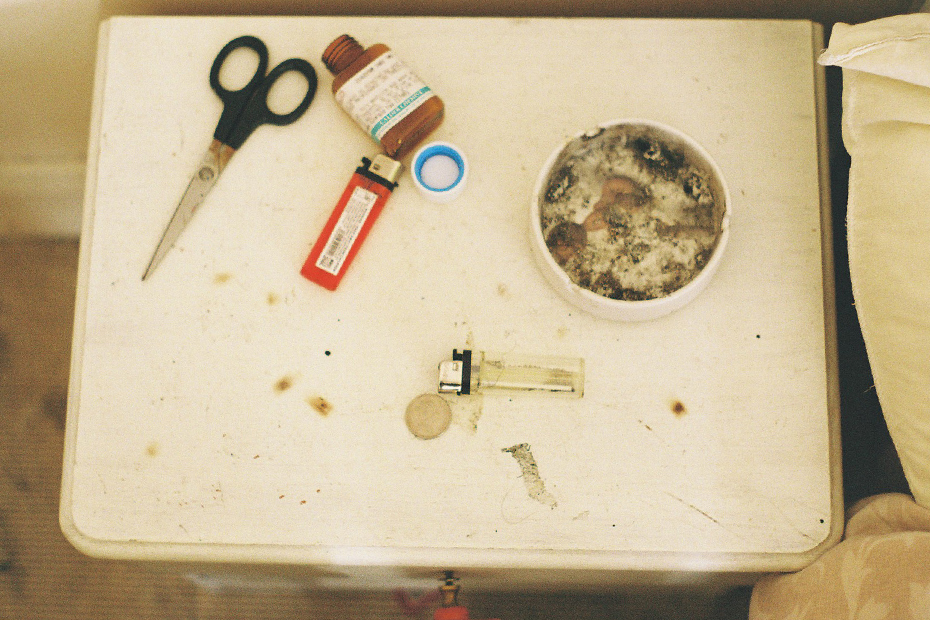
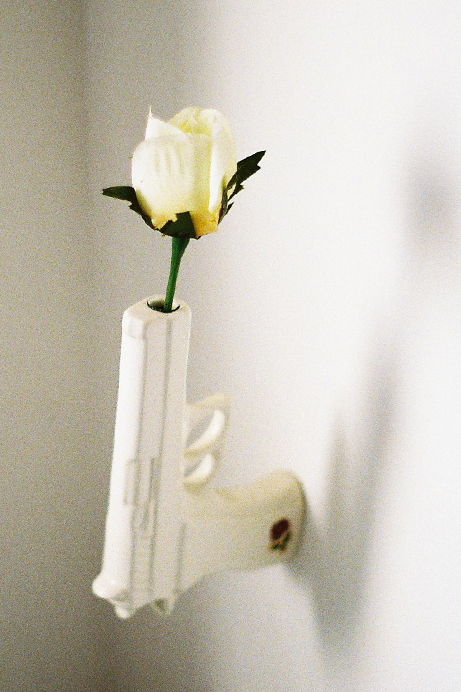
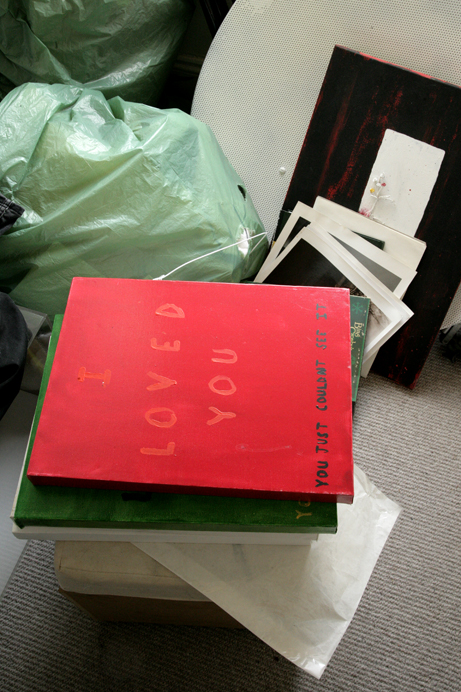
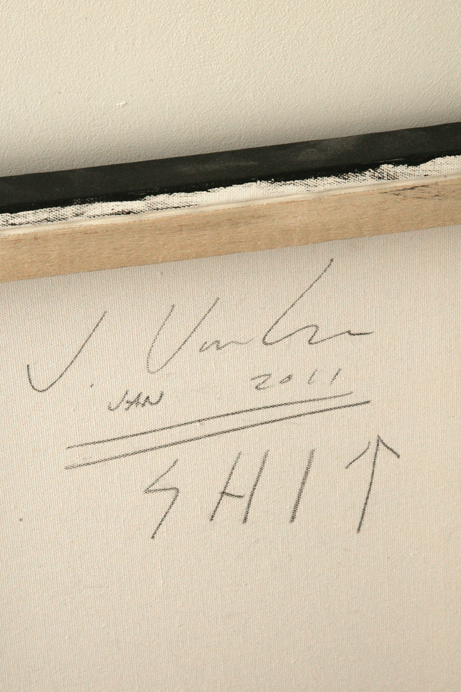
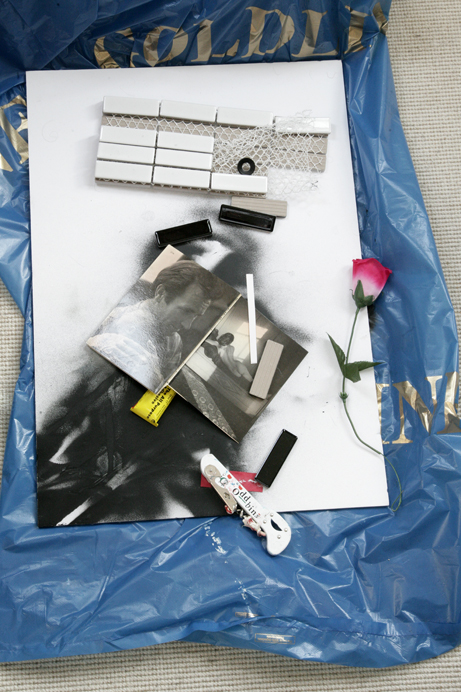
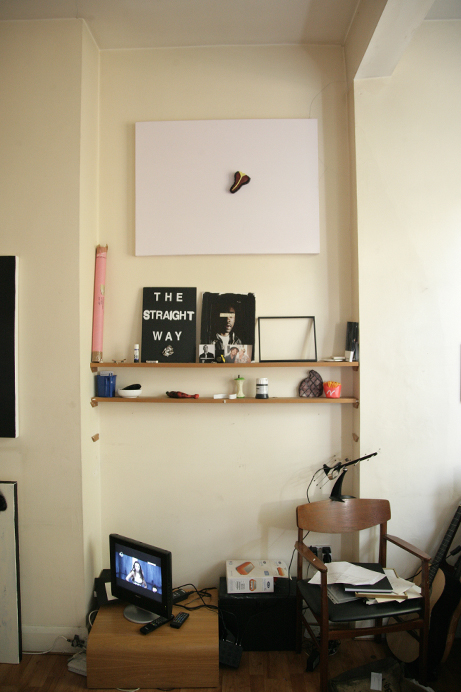
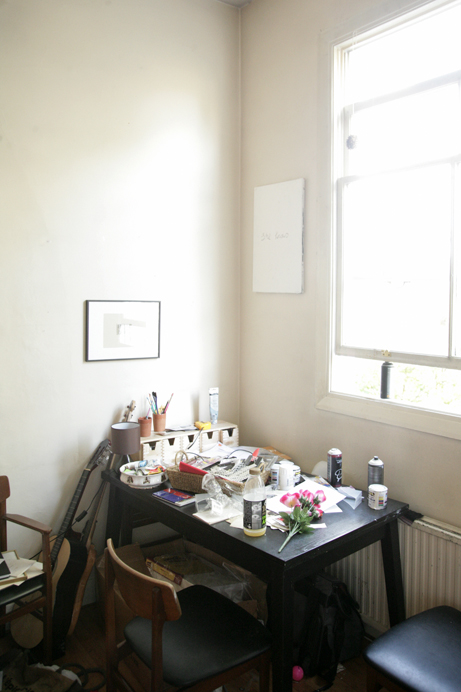
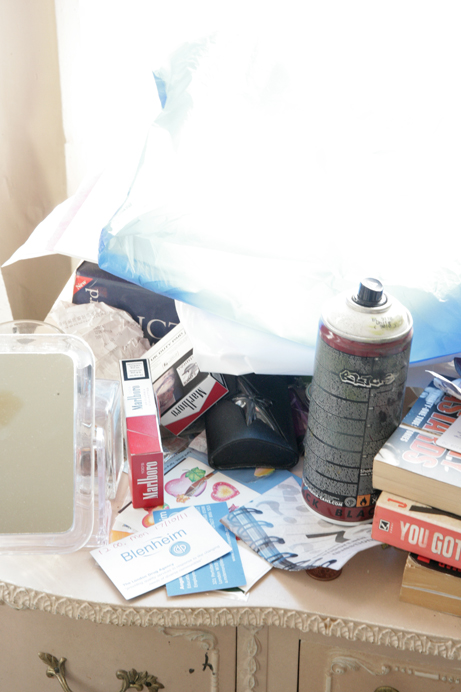
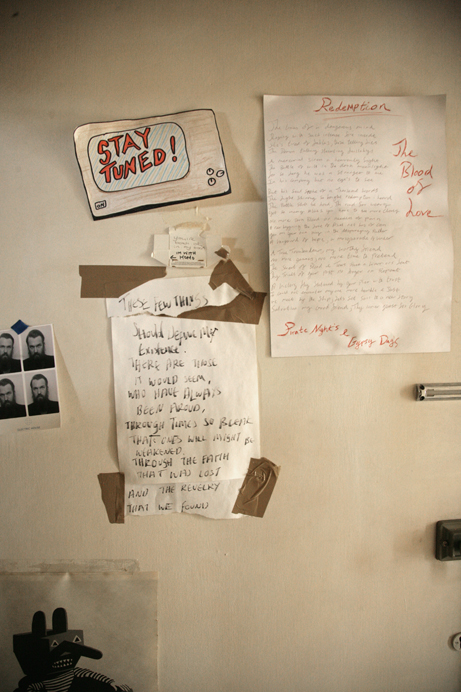
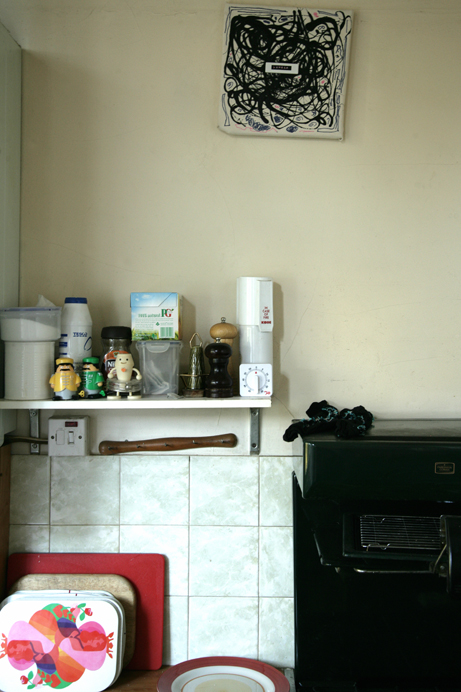
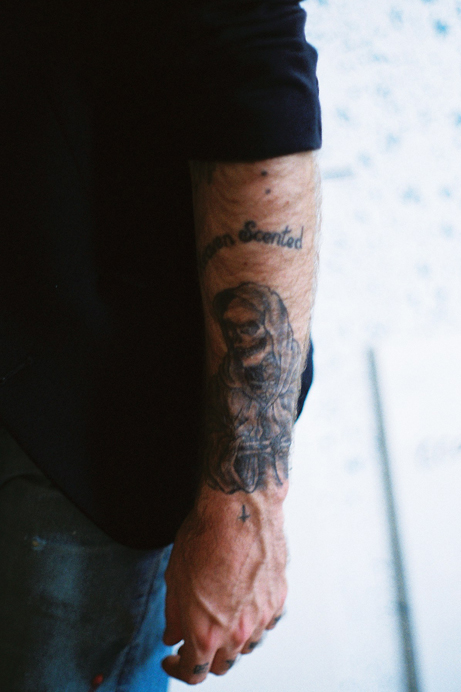
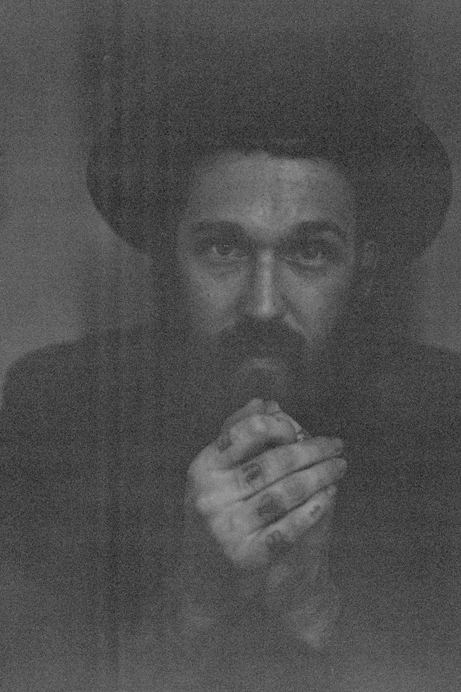
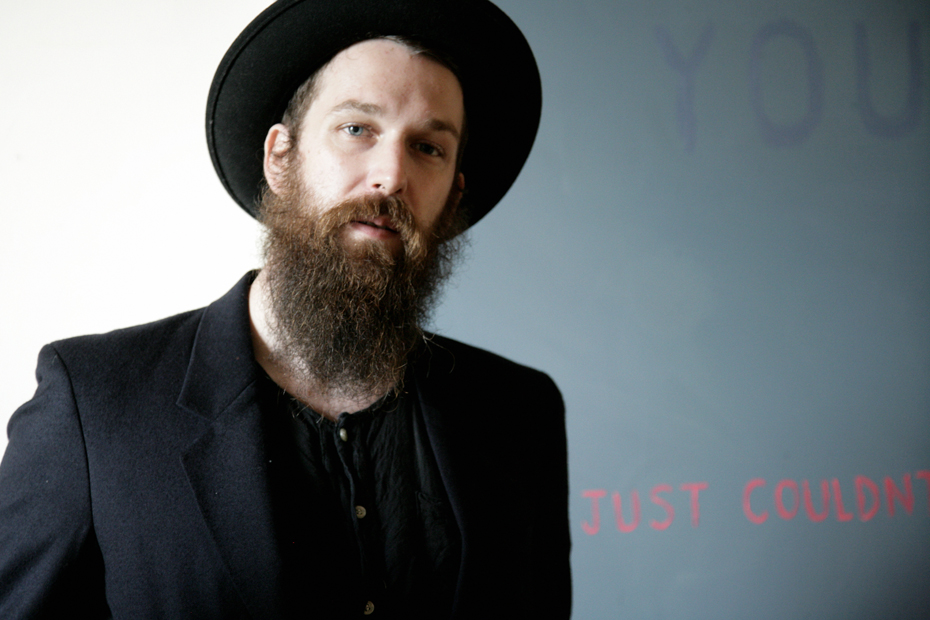
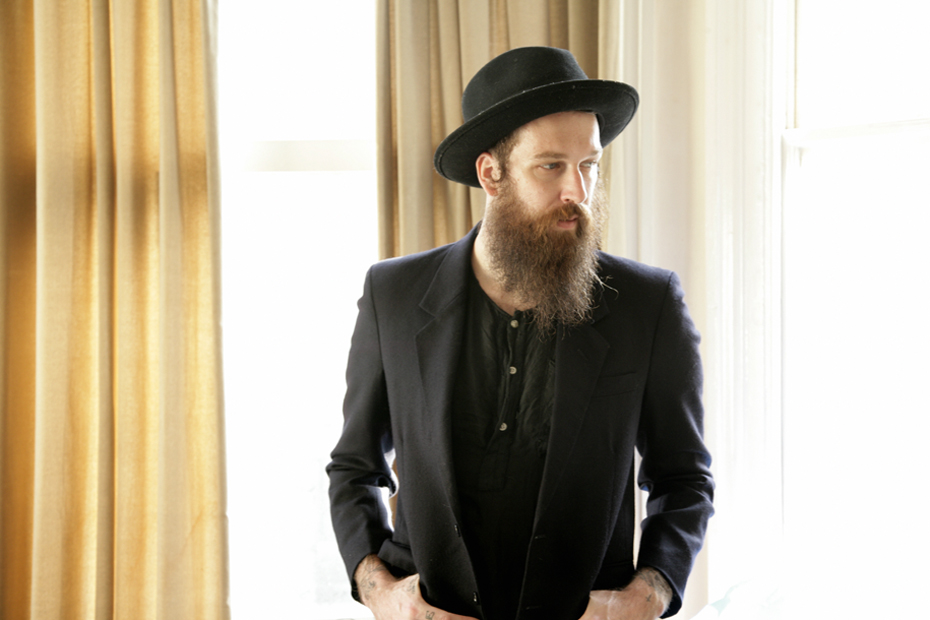
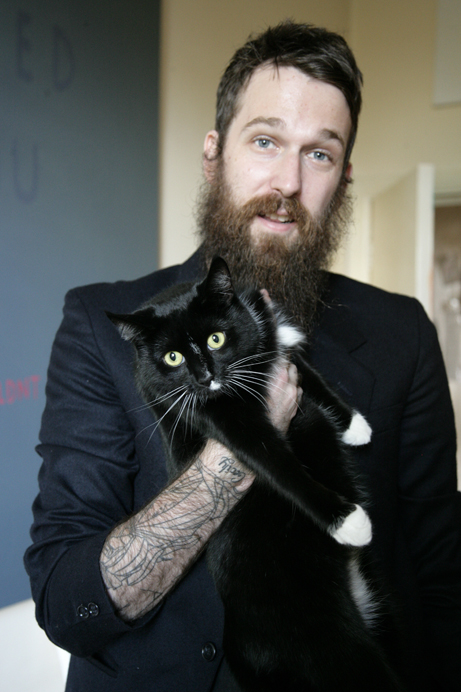
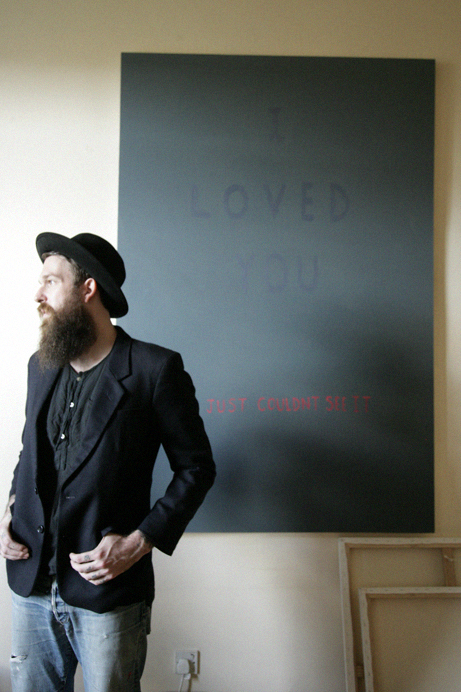
Why did you come to London?
I felt there were opportunities here. That and a relationship I was in that didn’t last. But the hope of getting her back certainly kept me here for some time.
Do you see any disadvantages living in this city?
Coming from the place I grew up in it’s difficult to see any disadvantages. I only see opportunity and hope living here. The winters are long and can get you down for sure. Winter in London for me is really grim and seems never-ending. Then the summer comes and only seems to last for a week or two if you’re lucky, but I guess that’s England in general. London is what you make out of it. If you want to do anything – certainly in the creative fields – then London is where you have to be in England. You can only make your own disadvantages. I believe it’s there for the taking and anything is possible in London, just as it is in New York. There’s something very special happening in London at the moment. It’s only a matter of time before the rest of the world becomes aware of it.
What are your favorite places here?
It changes really, but Trellick Tower in West London has always been my favorite building. I like Shoreditch House and Soho House to eat – mainly because I eat free there as they have some of my work up. Other than that I like my bed.
Is there any other city that you could imagine living in?
Yes for sure. I’ve lived in New York and could easily live there again, and most probably will one day. I’d like to live in Berlin one day too. I’ve never been to Berlin but have many friends there, and have heard nothing but good things about the place. Everyone has their opinion on what is the best city in the world, and it always seems to come down to New York, London or Berlin. For me they are the places to be right now as a young artist.
Why did you decide to move to West London and what do you like about the area you’re living in?
I chose West because initially that’s where my ex-girl lived. But I’ve always liked the vibe and history of West London, going back to the days when The Clash were about. It used to be a really poor run-down area, and it’s only in the last ten years or so it became attractive. All my friends love East and that’s where the majority of the creatives in London live. I do spend quite a lot of time in East London, but I like the fact I can come back West to relative normality and get on with my projects. Living East you’re never far away from some party at 5am in the morning, and I can quite easily get sucked into all that. Living West I can just be in my own bubble and create.
Do you collect anything?
Yes I do, I collect rubber and plastic dog toys. I’m not sure why – I only started recently. I like the bacon ones, and I have a really great fake McDonalds bag of French Fries. I’m always on the look out for dog toys – the lamer the better. They just look so hopeless. Do you give it to your dog as a gift, as a mark of respect, or to keep it quiet or entertained?!
Can you show us things in your flat that mean something to you?
My front door keys and my mobile phone. There’s nothing really that means much to me to be honest.
How far is your flat a reflection of you?
It’s my twin. Messy, unkempt, deserted, lonely.
Do you work in your flat?
At the moment yes. I recently moved out of my studio but have more than enough room to create what I need to. I’m about to move into a new studio though, so I can concentrate on bigger pieces.
Are there any rituals to get you into working/creating mood?
Not Really. It’s a 24/7 thing for me. My mind is always turned on and thinking of new ideas. It’s just a case of filtering through the shit and fishing out the good ideas. But I’m getting better at that now as time goes by.
Do you remember your first artistic work?
My first artistic work would have probably been at school. If you don’t mean school, the first piece I did that means anything was the Jesse Owens piece. I was living in New York at that time and I found an old stack of New York Posts dating back to the 40’s in someone’s house – and I stole the bottom load, the really old lot. Amongst them was a picture of Jesse Owens around that time that he won the Olympics in Berlin. When I was back I cut words out, – I think from a Charles Bukowski book – and put these separate words into a question: ‘Have you ever really loved anyone?’ and just stuck them in the middle. I guess that was the first piece.
How did you come to make art?
I don’t know, I didn’t have that many options. By the time I’d started, I’d spent the majority of my twenties not really doing much – kind of partying hard. Then the Jesse Owens thing happened – it ended up being in the Tate Modern – and from that I just got people becoming interested in me – just because of that one piece and I was like “Wow, I can make a career out of this”.
So collage was the first medium you worked with?
Yeah, collages. I can’t paint unfortunately. Well, not very well. It just happened really naturally, that I found this medium.
Do you look first for the method you want to make your art-work through, or does the effect come first?
The method just came out of self-confidence. After getting the confidence from doing the Jesse piece, I just started making other work in the same way. I went back up to Hull, to visit my parents. I found a lot of old photographs of my family ranging back to the 1920’s, even further. I did the same thing. I just stuck heartfelt texts on there and that got a good response as well, which gave me the confidence to really make art out of anything and not really bother about what people thought. I didn’t go to art school. I don’t know the rules so I’m not afraid to break them. Not that there are any rules anyway, but I just do my thing. Throw paint on canvas or make collages or make installations out of whatever, old satellite dishes. If I’m happy with it then I’m cool.
Through which medium do you feel you can express your ideas best?
Collages I guess. Underneath I’m a frustrated musician that can’t sing and can’t play an instrument. I can rap a little bit, but I kind of keep that to myself. When I’m putting words to images – that seems to be my strength. Matching an image with words and marrying the two and creating something heartfelt. Somebody once said that I have the ability to make somebody feel two different emotions with my work, either laugh or nearly cry, which is cool.
The people in your photographs, are they friends or do you find people to be part of the picture?
They are all friends. In my photography you can see the people that I came across over the last ten years of my life.
You’ve said collage is the most natural and effective medium for you – how important is photography to you?
I’m definitely not a photographer. I don’t want to be a photographer and I can’t stand it when people put ‘Richie Culver: Photographer’. I don’t even think I’ve got a camera at the moment. There was a time in my life when I had a camera and the majority of time I was just taking photographs, just doing it. And then I met a few people, the right people I guess, and showed them my photographs and they were like “Wow, these are really good”. My photography is something that I’m going to attack at a later date probably, do a show or two or whatever, but at the moment it’s definitely about the art.
Your work is heavily autobiographical and based on your personal experiences. How do you feel about revealing such personal and honest art works to an audience of strangers?
I’ve got no fear of it. I really haven’t got any fear. If I’m 100% happy with what I’ve done, nobody can change my mind. I really trust my judgement, on other people’s work as well. You know with my opinion on stuff it’s like the be all and end all – something that I need to work on. Certainly with my own work it is. I didn’t go to art school so I have no fear of anything in the art world really. I express myself. If I’m happy with it then I’m happy with it.
Do you feel like certain things about you come out in your work?
Vulnerability I guess. Coming from a working class background from Hull, I used to work in factories and stuff like that and to think that today I’m putting pieces on walls of galleries saying ‘I loved you, you just couldn’t see it’ nobody would have thought that. Vulnerability.
Where does your interest in working with the human inability to communicate come from?
I guess it comes from my inability to communicate with people. Yeah, every human being has their little hang-ups – you just feel lost in the world sometimes. I guess that’s a part of it. Yeah, I struggle with it slightly. It just happened really naturally that this was a subject I broached. I’m not going to do a show about something like the state of the country, it has to be about personal subjects that I struggle with or enjoy, I guess.
Your work was featured in a group exhibition in the Tate Modern last year. How did this come about?
There is this thing called The Museum of Everything and I showed the Jesse piece to my friend, he is the curator dude there. He said I should take it down to the Tate. I turned up with that little thing that I’d just done and then they liked it and they put it up. Again, because I didn’t go to art school, the Tate was just another place, I didn’t really realize what a grand, important place it was. You know I’m not stupid, I knew what the Tate Modern was, but I was just kind of like, “cool.”
What did this opportunity mean to you in this particular time of your life?
That meant a lot to me at that time. I just got back from living in New York and yeah that was definitely the start of me realizing this is something I can pursue and do for real. When I did the Jesse piece it was the first time my work affected me – I was happy with it and it affected me emotionally. My confidence grew and then after people had seen it in the Tate that just gave me more confidence. It’s just a confidence thing and it’s nice to have the Tate Modern as the first place that I ever exhibited.
What’s next for you?
I’ve just finished a project for Eastpak where I was asked, along with Johnny Marr from The Smiths, to create three bags in aid of HIV. I have work currently showing at the Whisper Gallery London and I’m in talks with a number of brands regarding collaborations. I’m starting a new photographic project using lots of my girlfriends. I’m going to be doing a show with Sarah Maple next year, possibly in London and New York. I’ll also be doing a show around the time of the London Olympics based upon my Jesse Owens piece in the 1936 Berlin Olympics, which was exhibited at Tate Modern last year. I’m really excited about that one. I have work up in Electric House at the moment also. There is loads more but that’s all I can remember right now.
Photography: George Hields and Ben Benoliel
Interview & Text: Lilli Heinemann
